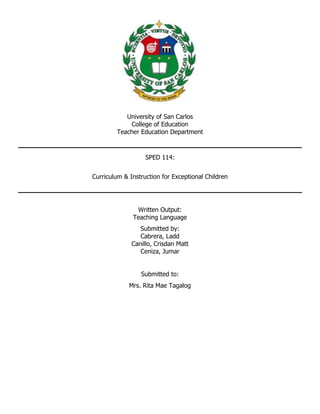
Teaching language
- 1. University of San Carlos College of Education Teacher Education Department SPED 114: Curriculum & Instruction for Exceptional Children Written Output: Teaching Language Submitted by: Cabrera, Ladd Canillo, Crisdan Matt Ceniza, Jumar Submitted to: Mrs. Rita Mae Tagalog
- 2. A person's proficiency in a language refers to the degree to which that person is able to use the language. Language is used for various purposes. In education we can classify the uses of language into two dimensions: the social dimension and the academic dimension (Cummins, 1981). Cummins refers to the skills necessary for social interactions involving language as Basic Interpersonal Communication Skills (BICS). The skills involved in everyday communication -listening, speaking, carrying on basic conversation, understanding speakers. and getting one's basic needs met. Cummins refers to the language skills necessary to function in an academic situation as Cognitive/Academic Language Proficiency (CALP). The skills that are needed to succeed in the academic classroom, including problem solving, inferring, analyzing, synthesizing, and predicting. They go beyond the BICS, demanding much greater competence in the language. Stages of Language Acquisitin
- 3. Natural approach by Stephen Krashen Comprehensible Input: Students learn best when exposed to samples of the target language that are at or just above the student's current level of acquisition of the language. Teachers can ensure that the language used in the classroom is comprehensible by evaluating the students on the Stages of Language Acquisition chart on the next page and can design activities that ensure input and output at an appropriate level for the student. Low Affective Filter: Students are best able to absorb and mentally process the language input they receive when they are in an environment where they are relaxed and their anxiety level is low. The teacher can provide this by making the classroom a warm, supportive place where students feel free to take risks with language. The Monitor: Krashen hypothesizes that language instruction results in the creation of a mental monitor through which the learner filters spoken and written output. The monitor aids learners in achieving accuracy, but may hinder the development of fluency. The ideal is a balance where the student has opportunities for unrestricted fluency and for using the monitor to "edit" and develop accuracy. Meaningful Communication: Research shows that more learning takes place when students are engaged in communication that is meaningful to them because more of the content and structure of the communication enters long-term memory. Communication is meaningful when it touches on the students' real lives or centers on topics chosen by and of interest to the students. Teachers can ensure that meaningful communication happens in the classroom by allowing students to choose books, materials and topics that interest them when appropriate.
- 4. Some of the ways we can foster language development are: 1. Using nursery rhymes to let the students hear the rhythm and flow of language 2. Singing simple songs with the students and using call-and-response activities 3. Using body language in songs, stories, and in everyday activities 4. Name objects Set out a set of common objects and have students name them and discuss different attributes (size, color, weight, shape) Naming and touching body parts through active rhymes, games, and songs Grouping and naming pairs or objects that go together 5. Introducing new words Through stories. Through looking at magazines together and discussing the students. On neighborhood walks or field trips By making word cards with a word and its picture. In environmental print 6. One-to-one conversations Model correct pronunciation and grammar Model complete sentences Model listening and responding to each other Model questioning and answering 7. Engaging in conversations about the students journal entries 8. Telling simple stories which involve the students responding 9. Reading favorite stories over and over and then letting the students tell them to you 10.Asking open-ended questions 11.Facilitating dramatic play situations In the housekeeping area Outside Using prop boxes Using found objects to stimulate imaginative situations Fill a box with objects and ask the students to tell about what they want to share with the object they chose 12.Using puppets To encourage a shy child to speak To do puppet shows of familiar stories To encourage students to make up their own scenarios To invite students to come to a small group activity 13.Chart activities recording a favorite _____ (color, shape, animal, activity begin a poem and have them help you rhyme it have students predict what will happen in a certain situation and record it later, follow up and see if the predictions came true 14.Do webbing activities with the students write a topic word and have the children tell you what they know about it record what they would like to know about the topic 15.Use finger plays to encourage language http://www.meddybemps.com/7.021.html
